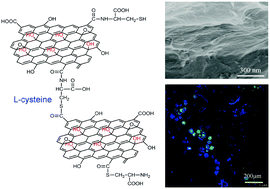Conductive graphene oxide hydrogels reduced and bridged by l-cysteine to support cell adhesion and growth†
Abstract
Graphene composite hydrogels have wide potential applications as biomaterials. Herein, L-cysteine was used to reduce graphene oxide (GO) into hydrogels. Systematic investigations by FTIR, Raman spectroscopy, TEM, and other methods reveal that the reduced graphene oxide (rGO) nanosheets are likely bridged by L-cysteine molecules, forming porous hydrogels with the rGO nanosheets stacked into layered structures on the walls. Such layered structures, as well as the reduction, are critical for the improvement of conductivity by four to five orders of magnitude in comparison to graphene oxide. In vitro cell culture experiments demonstrate excellent cell adhesion and growth on these reduced graphene oxide hydrogels. These conductive rGO hydrogels may find applications in electrical stimulation to facilitate cell adhesion and growth.



 Please wait while we load your content...
Please wait while we load your content...